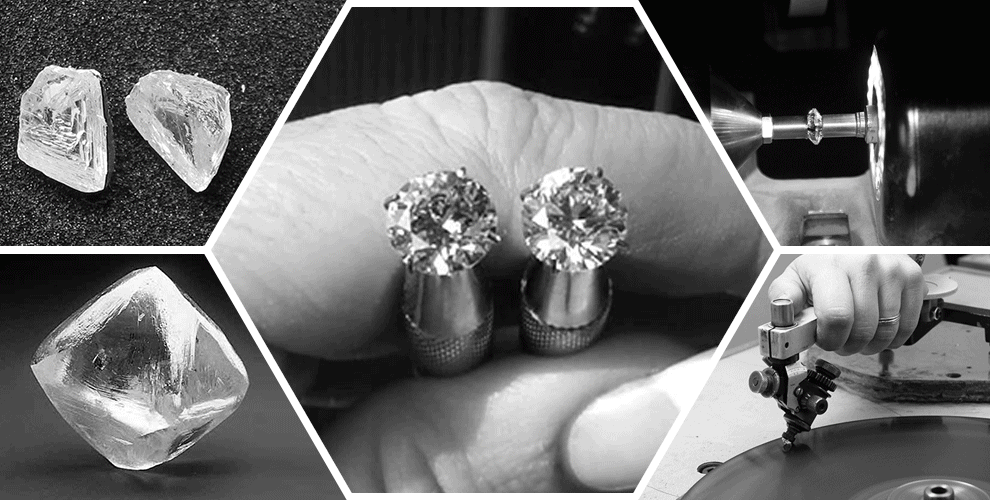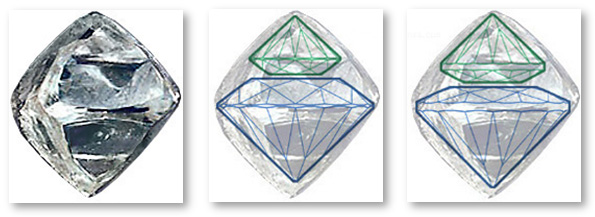Diamond Cutting Process
Diamond cutting is the term used to refer to the practice of changing a diamond from a rough stone to a faceted gemstone - a 'Polished Diamond'.
The process is incredibly difficult because diamond is such a hard material and to facet and shape requires a large amount of knowledge, skill, equipment and technique to complete correctly. The diamond cutting process consists of five steps: Planning, Cleaving, Bruting, Polishing and the Final Inspection.

During the planning process, manufacturers will analyze a rough diamond focusing on two things. The first focus is the return that the diamond will provide once the diamond has been cut. The second is how quickly the diamond will be sold once completed. Manufacturers will use 3D technology to scan diamonds onto a program which then allows them to identify each inclusion on the soon to be gemstone. Once the diamond cutting has begun, colour restoration is a key objective in mainting value and authenticity.

Cleaving the diamond is the process of seperation. The rough diamond will be seperated and completed as seperate gemstones. This is sometimes known as sawing as manufacturers will use lasers or diamond encrusted saws to seperate or cut through the rough diamond.
Bruting is the art of cutting a diamond into a round. Diamonds are rounded using either a laser, a diamond or disk or by using to diamonds cutting against one another. Using computer software to measure a diamonds roundness and ideal cut gives an accurate result.
 Diamond Polishing is the second to last step of the process. The diamond is placed on a jig that can be adjusted to the required polishing angle. The diamond is lowered onto a diamond encrusted disc that is spinning at up to 2000 revolutions per minute. This disc literally shaves the facets onto the diamond - only diamond can cut diamond as it is one of the hardest materials. The symmetry and properties of the diamond are checked and recorded as the main facets are placed on the diamond. After the crossworking is completed the diamond is then finalized and the main facets are smoothed. This is referred to as polishing the diamond. Each of the 58 facets are analysed to ensure the angle is correct (cut), that they align with corresponding facets (symmetry) and that the polishing or sanding lines are minimal (polish). A diamond cutter is always trying to get an Excellent cut, Excellent symmetry and Excellent polish so the diamond can sparkle and have super high performance. Here at Polished Diamonds we specialise in the triple excellent cut grade for the best sparkle.
Diamond Polishing is the second to last step of the process. The diamond is placed on a jig that can be adjusted to the required polishing angle. The diamond is lowered onto a diamond encrusted disc that is spinning at up to 2000 revolutions per minute. This disc literally shaves the facets onto the diamond - only diamond can cut diamond as it is one of the hardest materials. The symmetry and properties of the diamond are checked and recorded as the main facets are placed on the diamond. After the crossworking is completed the diamond is then finalized and the main facets are smoothed. This is referred to as polishing the diamond. Each of the 58 facets are analysed to ensure the angle is correct (cut), that they align with corresponding facets (symmetry) and that the polishing or sanding lines are minimal (polish). A diamond cutter is always trying to get an Excellent cut, Excellent symmetry and Excellent polish so the diamond can sparkle and have super high performance. Here at Polished Diamonds we specialise in the triple excellent cut grade for the best sparkle.
The final inspection of the diamond involves a thorough clean of the diamond in acids, and then an examination to ensure the diamond meets the quality standards and expectations of the manufacturer. The diamond is then sent to a diamond grading facility to have an independant review of the finished product. This involves checking the carat weight, diamond colour and clarity and the cut grade including symmetry and polish. We recommend the GIA or Gemological Institute of America to grade all diamonds as they are neutral, fair and can be trusted to correctly certify a diamond. As you can now appreciate, there are many steps in cutting a rough diamond, it is extremely difficult and here at Polished Diamonds you are welcome to contact us and speak with our qualified staff and explore the possibilities.





Facebook Twitter YouTube Google Instagram pinterest